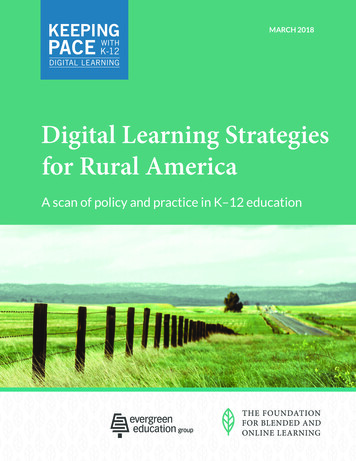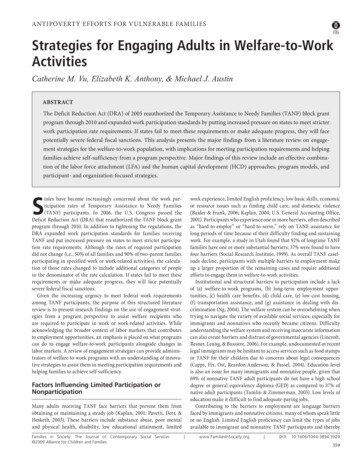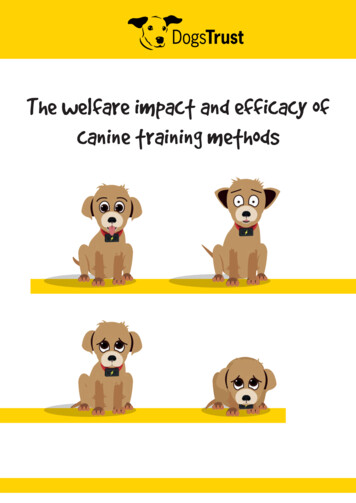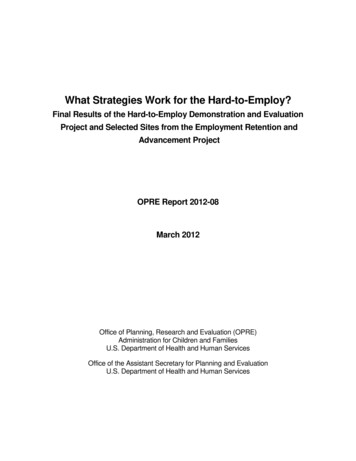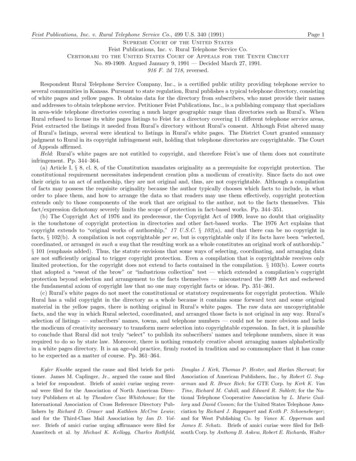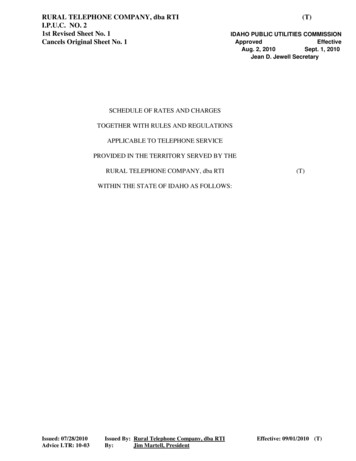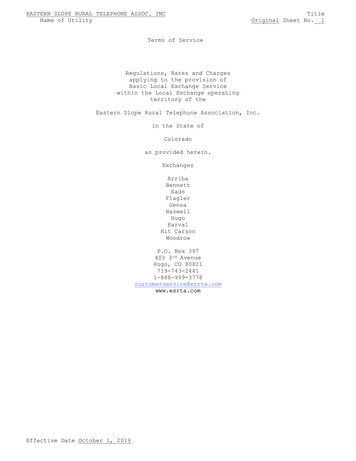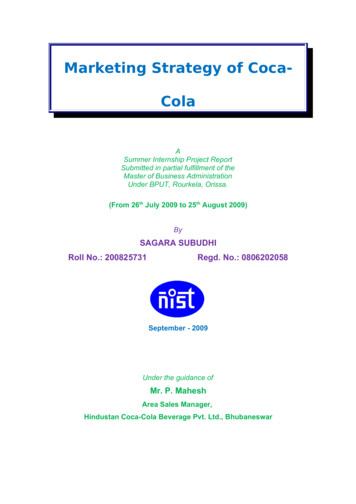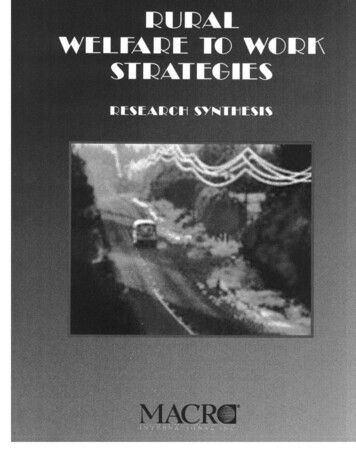
Transcription
RURALWELFARE TO WORKSTRATEGIESResearch Synthesisprepared byEllen L. Marks, Macro International Inc.Sarah Dewees, Rural Policy Research InstituteTammy Ouellette, Macro International Inc.Robin Koralek, Macro International Inc.11785 Beltsville DriveCalverton, MD 20705June 10, 1999
TABLE OF CONTENTSPageEXECUTIVE SUMMARY . . . . . . . . . . . . . . . . . . . . . . . . . . . . . . . . . . . . . . . . . . . . . . . . . . viiI.INTRODUCTION . . . . . . . . . . . . . . . . . . . . . . . . . . . . . . . . . . . . . . . . . . . . . . . . . . . . 1The Setting . . . . . . . . . . . . . . . . . . . . . . . . . . . . . . . . . . . . . . . . . . . . . . . . . . . . . . . . . . . 1The Rural Welfare to Work Strategies Project . . . . . . . . . . . . . . . . . . . . . . . . . . . . . . . 3II.BACKGROUND . . . . . . . . . . . . . . . . . . . . . . . . . . . . . . . . . . . . . . . . . . . . . . . . . . . . . 8Demographics of Rural America . . . . . . . . . . . . . . . . . . . . . . . . . . . . . . . . . . . . . . . . . . 8Rural Employment . . . . . . . . . . . . . . . . . . . . . . . . . . . . . . . . . . . . . . . . . . . . . . . . . . . . . 9Rural Poverty . . . . . . . . . . . . . . . . . . . . . . . . . . . . . . . . . . . . . . . . . . . . . . . . . . . . . . . . 13The Rural Welfare Population . . . . . . . . . . . . . . . . . . . . . . . . . . . . . . . . . . . . . . . . . . . 15Summary . . . . . . . . . . . . . . . . . . . . . . . . . . . . . . . . . . . . . . . . . . . . . . . . . . . . . . . . . . . 17III.WELFARE REFORM IN RURAL AREAS . . . . . . . . . . . . . . . . . . . . . . . . . . . . . . 18Absorbing Welfare Recipients into the Rural Economy . . . . . . . . . . . . . . . . . . . . . . . 19Summary . . . . . . . . . . . . . . . . . . . . . . . . . . . . . . . . . . . . . . . . . . . . . . . . . . . . . . . . . . . 20IV.WELFARE TO WORK STRATEGIES . . . . . . . . . . . . . . . . . . . . . . . . . . . . . . . . .Rural Economic Development . . . . . . . . . . . . . . . . . . . . . . . . . . . . . . . . . . . . . . . . . . .Factors Influencing Rural Economic Growth . . . . . . . . . . . . . . . . . . . . . . . . . . . .Approaches to Job Creation in Rural Communities . . . . . . . . . . . . . . . . . . . . . . .Work with Existing Employers to Create Jobs and Improve Benefits . . . . . . .Encourage Employers to Expand Lines of Business . . . . . . . . . . . . . . . . . . . .Attract New Employers . . . . . . . . . . . . . . . . . . . . . . . . . . . . . . . . . . . . . . . . . .Provide Financial Capital . . . . . . . . . . . . . . . . . . . . . . . . . . . . . . . . . . . . . . . . .Capture More Local Dollars . . . . . . . . . . . . . . . . . . . . . . . . . . . . . . . . . . . . . .Capture More Global Dollars . . . . . . . . . . . . . . . . . . . . . . . . . . . . . . . . . . . . . .Workforce Development . . . . . . . . . . . . . . . . . . . . . . . . . . . . . . . . . . . . . . . . . . . . . . .Employer Involvement . . . . . . . . . . . . . . . . . . . . . . . . . . . . . . . . . . . . . . . . . . . . . .Job Search and Job Readiness . . . . . . . . . . . . . . . . . . . . . . . . . . . . . . . . . . . . . . . .Education and Training . . . . . . . . . . . . . . . . . . . . . . . . . . . . . . . . . . . . . . . . . . . . .Soft Skills Development . . . . . . . . . . . . . . . . . . . . . . . . . . . . . . . . . . . . . . . . . . . .Unpaid Work Experience . . . . . . . . . . . . . . . . . . . . . . . . . . . . . . . . . . . . . . . . . . . .Publicly Funded Jobs . . . . . . . . . . . . . . . . . . . . . . . . . . . . . . . . . . . . . . . . . . . . . . .Workforce Investment Act . . . . . . . . . . . . . . . . . . . . . . . . . . . . . . . . . . . . . . . . . . .Community Commitment . . . . . . . . . . . . . . . . . . . . . . . . . . . . . . . . . . . . . . . . . . . . . .Rural Welfare to Work Strategies: Research Macro International Inc.
Transportation . . . . . . . . . . . . . . . . . . . . . . . . . . . . . . . . . . . . . . . . . . . . . . . . . . . . . . .Rural Transportation Needs . . . . . . . . . . . . . . . . . . . . . . . . . . . . . . . . . . . . . . . . . .Public Transportation . . . . . . . . . . . . . . . . . . . . . . . . . . . . . . . . . . . . . . . . . . . . . . .Private Vehicles . . . . . . . . . . . . . . . . . . . . . . . . . . . . . . . . . . . . . . . . . . . . . . . . . . .Transportation Strategies . . . . . . . . . . . . . . . . . . . . . . . . . . . . . . . . . . . . . . . . . . . .Child Care . . . . . . . . . . . . . . . . . . . . . . . . . . . . . . . . . . . . . . . . . . . . . . . . . . . . . . . . . .Supply of Child Care . . . . . . . . . . . . . . . . . . . . . . . . . . . . . . . . . . . . . . . . . . . . . . .Relative vs. Center-Based Child Care . . . . . . . . . . . . . . . . . . . . . . . . . . . . . . . . . .Child Care in Rural vs. Urban Areas . . . . . . . . . . . . . . . . . . . . . . . . . . . . . . . . . . .Child Care Strategies . . . . . . . . . . . . . . . . . . . . . . . . . . . . . . . . . . . . . . . . . . . . . . .Hard-to-Serve Welfare to Work Participants . . . . . . . . . . . . . . . . . . . . . . . . . . . . . . . .Identifying Barriers . . . . . . . . . . . . . . . . . . . . . . . . . . . . . . . . . . . . . . . . . . . . . . . .Multiple Barriers . . . . . . . . . . . . . . . . . . . . . . . . . . . . . . . . . . . . . . . . . . . . . . . . . .Effects of Barriers on Ability to Work . . . . . . . . . . . . . . . . . . . . . . . . . . . . . . . . . .Approaches for Serving for the Hard-to-Serve Population . . . . . . . . . . . . . . . . . .Restructuring Administrative Elements of the Welfare System . . . . . . . . . . . . . . . . .Case Management . . . . . . . . . . . . . . . . . . . . . . . . . . . . . . . . . . . . . . . . . . . . . . . . .Coordination of Services . . . . . . . . . . . . . . . . . . . . . . . . . . . . . . . . . . . . . . . . . . . .Changing the Culture of the Welfare Office . . . . . . . . . . . . . . . . . . . . . . . . . . . . .Summary . . . . . . . . . . . . . . . . . . . . . . . . . . . . . . . . . . . . . . . . . . . . . . . . . . . . . . . . . . IONS . . . . . . . . . . . . . . . . . . . . . . . . . . . . . . . . . . . . . . . . . . . . . . . . . . . . 56REFERENCES . . . . . . . . . . . . . . . . . . . . . . . . . . . . . . . . . . . . . . . . . . . . . . . . . . . . . . . . . . . . 58Rural Welfare to Work Strategies: Research SynthesisivMacro International Inc.
LIST OF EXHIBITSPage123456789101112131415Characteristics of States Participating in ACF’s Rural Welfare to WorkStrategies Project . . . . . . . . . . . . . . . . . . . . . . . . . . . . . . . . . . . . . . . . . . . . . . . . . . . . . . . . . 4Rural Welfare to Work Strategies Project: Information fromState Grant Applications . . . . . . . . . . . . . . . . . . . . . . . . . . . . . . . . . . . . . . . . . . . . . . . . . . . 7Educational Attainment as of March 1997 . . . . . . . . . . . . . . . . . . . . . . . . . . . . . . . . . . . . . 9Jobs in Nonmetropolitan Areas, by Industry, 1996 . . . . . . . . . . . . . . . . . . . . . . . . . . . . . . 10Earning by Job Sector, 1990 . . . . . . . . . . . . . . . . . . . . . . . . . . . . . . . . . . . . . . . . . . . . . . . 11Comparison of Urban and Rural Family Structure: Share of Poor Families . . . . . . . . . . 14Comparison of Rural Female-Headed Families Receiving Welfare withUrban Female-Headed Families Receiving Welfare . . . . . . . . . . . . . . . . . . . . . . . . . . . . . 17The Rural Prism . . . . . . . . . . . . . . . . . . . . . . . . . . . . . . . . . . . . . . . . . . . . . . . . . . . . . . . . . 21Job Creation Strategies: Working with Rural Businesses . . . . . . . . . . . . . . . . . . . . . . . . . 29Strategies to Encourage New Business at Existing Employees . . . . . . . . . . . . . . . . . . . . . 30Summary of Strategies for Attracting New Businesses . . . . . . . . . . . . . . . . . . . . . . . . . . . 31Ways to Plug “Leaks” in Community Wealth . . . . . . . . . . . . . . . . . . . . . . . . . . . . . . . . . . 33Transportation Strategies in Rural Areas . . . . . . . . . . . . . . . . . . . . . . . . . . . . . . . . . . . . . . 41Positive Factors Resulting from Rural Transportation Programs . . . . . . . . . . . . . . . . . . . 42Child Care Strategies . . . . . . . . . . . . . . . . . . . . . . . . . . . . . . . . . . . . . . . . . . . . . . . . . . . . . 45Rural Welfare to Work Strategies: Research SynthesisvMacro International Inc.
EXECUTIVE SUMMARYThe enactment of the Personal Responsibility and Work Opportunity Act in 1996 signalled adramatic shift in the nation’s approach to providing assistance to those among the country’sneediest populations. The concept of welfare in the United States shifted from cash assistance toeconomic self-sufficiency.Rural welfare populations possess unique characteristics and face unique circumstances that willaffect their ability to achieve the requirements and intent of welfare reform. To build knowledgeand research about effective approaches in working with rural populations, the Administrationfor Children and Families (ACF) awarded planning grants to ten states to help develop and studystrategies to move rural families from welfare to work.Although there are extensive bodies of literature both on rural matters and on welfare-relatedmatters, there is relatively little information about rural welfare issues. This report synthesizesavailable knowledge and, where appropriate, draws inferences from studies about the ways thatwelfare reform is likely to affect rural welfare to work strategies.BACKGROUNDRural America, despite perceptions to the contrary, displays a wide range of cultural andeconomic diversity and is home to many different economic activities, including farming,mining, manufacturing, and services. Rural areas have populations that are proportionately older,less educated, and more racially homogeneous than urban areas.In terms of employment, most rural residents have jobs in the service sector. Wages are lower inrural areas than in urban areas. When compared with urban workers, rural workers are morelikely to earn minimum wage and more likely to be underemployed.Rural poverty is more severe, more persistent, and often less visible than urban poverty. As awhole, the rural population in the United States has lower incomes, lower employment rates, andhigher poverty levels than urban and suburban populations.Relatively little information is available about the rural welfare population, but the literatureshows that they are slightly more likely to be married and more likely to be working (or at leastreport working) than their urban counterparts. Welfare participation is lower, and spells onpublic assistance are shorter in rural areas than in urban ones.Rural Welfare to Work Strategies: Research SynthesisviMacro International Inc.
WELFARE REFORM IN RURAL AREASRural communities may face significant barriers in implementing welfare reform because of:Cgeographic isolation and population dispersion;Cdepressed economies with high levels of unemployment and underemployment;Cspatial inequities in transportation, child care, technology and infrastructure;Ceducational attainment and job opportunities and advancement; andClimited administrative skills and expertise for implementing decentralized programs.Of the issues facing rural communities under welfare reform, absorbing welfare recipients intorural economies may be the most significant challenge. This challenge is particularly acutebecause the number and types of jobs available to rural workers are not the same as thoseavailable to workers in suburban or urban areas—they have more seasonal jobs, have lowerlevels of manufacturing and technology jobs, and face geographic dispersion.WELFARE TO WORK STRATEGIESAlthough the present knowledge base to inform welfare to work strategies is vast, the wealth ofexisting information is largely silent on rural welfare to work strategies. To help inform ACF’sproject, we attempted to cull from the literature pertinent lessons about the intersection betweenkey features of rural areas and factors about welfare recipients’ abilities to achieve economicself-sufficiency. Findings are discussed in seven areas, each of which is summarized below.Rural Economic DevelopmentTo successfully move welfare recipients to self-sufficiency, rural communities will need toconsider strategies that will generate a sufficient number of good-paying, stable jobs. Creatingjobs and fostering economic development are more often achieved when woven into anorganized, holistic approach to rural job creation that includes:Cworking with employers to create jobs and improve benefits;Cencouraging employers to expand lines of business;Cattracting new employers;Cproviding financial capital;Rural Welfare to Work Strategies: Research SynthesisviiMacro International Inc.
Ccapturing more local dollars; andCcapturing more global dollars.Workforce DevelopmentResearch indicates that the most successful programs for achieving positive welfare to workoutcomes combine the “human capital” approach with a “work first” approach. The primarychallenges for welfare to work programs—helping recipients for whom the job search is notsuccessful, helping recipients find better jobs with higher wages, and helping recipients stayemployed—are best addressed through a variety of employer- and recipient-focused activities.These include linkages with local employers, support for job search and job readiness endeavors,education and training, soft skills development, unpaid work experience, and publicly fundedjobs.Community CommitmentBoth anecdotal and systematic evidence point to the value of community commitment ineffecting positive change among disadvantaged populations. Communities that work togetherand accept responsibility for devising and implementing welfare to work strategies are morelikely to experience greater success in helping people achieve economic self-sufficiency.TransportationRural areas present many unique conditions for the transportation challenge in welfare reform.Unlike urban areas, rural areas have fewer jobs available, and they may have greater distancesbetween job sites. With the influx of welfare participants who need transportation to travel toeducation, training, work experience, or employment locations, providing new transportationoptions to disadvantaged rural residents will be a critical feature of programs designed to help thepoor achieve economic self-sufficiency. Possible options include expanding publictransportation, facilitating private vehicle ownership, and using other strategies, such as publicschool buses, taxi subsidies, vouchers for gasoline, and carpooling.Child CareAs more and more parents enter the workforce to meet welfare reform requirements, the need forchild care will increase, providers may need to expand services during nontraditional hours, andservices may be necessary for sick or special needs children. Strategies to expand child care inrural areas include creating apprenticeship/training programs, forming collaboratives to establishchild care initiatives, developing child care facilities, and establishing incentives for employers toprovide assistance.Rural Welfare to Work Strategies: Research SynthesisviiiMacro International Inc.
Hard-to-Serve Welfare to Work ParticipantsAn unknown proportion of the rural welfare population faces barriers to employment, which mayinclude mental health problems, substance abuse, domestic violence, and low basic skills andlearning disabilities. Although there are no solid measures about the effects of barriers on awelfare recipient’s ability to secure and retain gainful employment, the hard-to-serve populationwill almost undoubtedly require greater assistance in complying with current work requirements.Approaches for serving this population include accurate assessment of the barriers, identificationof appropriate jobs, post-employment services, and intensive case management.Restructuring Administrative Elements of the Welfare SystemThe far-reaching changes of welfare reform include changes in administrative structures thatprovide services to welfare recipients. Rural agency staff may face additional challenges inimplementing welfare reform practices because they are less likely to have the human capital andfinancial resources needed for public administration, economic development, and strategicplanning. Three administrative aspects of the welfare system that are likely to affect practices inrural areas are case management, coordination of services, and changing the culture of thewelfare office.CONCLUSIONSThe research literature has very little systematic evaluative information about rural welfare towork strategies. That population and subject have received very little attention from the welfareresearch industry for several reasons, among them the low number of welfare recipients in ruralareas, which presents methodological challenges, results in less public and political attention, andwould require substantial resources to produce statistically valid findings.Although we tried to capitalize on available information and make plausible inferences fromother information about rural welfare programs and populations, a long list of research questionsremains unanswered. Foremost among them is: What set of strategies is most likely toproduce economic self-sufficiency, for what types of welfare recipients, andunder what conditions? Answers to this question can help policymakers, program planners,and community members as they work to accomplish the goals of welfare reform.Rural Welfare to Work Strategies: Research SynthesisixMacro International Inc.
I. INTRODUCTION1The current era of welfare reform grows from an evolution in public policy and public sentimenttoward the nation’s needy populations. For decades, welfare programs have struggled to balancethe moral responsibility of helping those in need with the economic responsibility of encouragingtheir self-sufficiency. Now, the balance has shifted to a philosophy that strongly emphasizes paidemployment, with limited public assistance to help low-income families achieve that end.THE SETTINGBeginning in the 1960s, federal welfare programs focused on recipients of Aid to Families withDependent Children (AFDC)—primarily women with children—to eliminate barriers toemployment and economic self-sufficiency. In 1988, Congress enacted the Family Support Actwith the goal of increasing the economic self-sufficiency of families receiving AFDC benefits.The legislation increased levels of child support enforcement and launched a new welfare towork initiative, the Job Opportunities and Basic Skills Training (JOBS) program. JOBS targetedlong-term AFDC recipients and emphasized education, skills training, job readiness activities,placement, case management, and two or more of the following: group and individual searches,on-the-job training, work supplementation, and community work experience (Gueron and Pauly,1991).Even as JOBS programs were implemented nationwide, the number of families receiving AFDCbenefits grew by 1.2 million between 1989 and 1993, and single mothers accounted for abouthalf of the growth (U.S. General Accounting Office, 1995c). Nationally, the AFDC caseloadaveraged 4.98 million per month in 1993 (U.S. General Accounting Office, 1995b), about 14million people total when recipients’ children are included.With the enactment of P.L. 104-193, the Personal Responsibility and Work OpportunityReconciliation Act (PRWORA), the United States instituted a profound shift in providingassistance to those among the nation’s neediest populations, and the president’s commitment to“end welfare as we know it” is being fulfilled. The country’s concept of welfare has shifted froma program that had attained entitlement status to a program that promotes achieving economicself-sufficiency.1The authors extend sincere thanks to the following, who commented on an earlier version of this synthesis:James Dolson, Helen Howerton, Jamie Kendall, and Howard Rolston of the Administration for Children andFamilies, U.S. Department of Health and Human Services; Bo Beaulieu, Southern Rural Development Center;Kathleen Miller, University of Missouri; and Ila Schneibel, Minnesota Department of Human Services.Rural Welfare to Work Strategies: Research Synthesis1Macro International Inc.
The block grant portion of PRWORA—Temporary Assistance for Needy Families (TANF)—includes numerous changes from previous welfare initiatives:CAfter two years of receiving TANF support, most recipients must work.CLifetime TANF limits of 5 years are imposed on welfare recipients (although states mayexempt 20 percent of their caseloads).CStates may qualify for bonus payments based on their “high performance” and reduction inout-of-wedlock births.CStates may use funds to create community service jobs, provide subsidies, or offer hiringincentives to employers.CUnmarried teenage parents must live with a responsible adult and participate in educationaland training activities.Already welfare reform is being hailed as a success (Harris, 1998). In conjunction with a healthyeconomy, efforts already begun under Sec. 1115 waivers designed to decrease dependency, theimposition of JOBS sanctions, and the implementation of TANF requirements, the United Stateshas witnessed a significant drop in welfare caseloads. From January 1993 to March 1998, thenumber of families receiving AFDC/TANF dropped by 35 percent; during that same period, 18states had the number of recipients receiving public support drop by more than 50 percent (U.S.Department of Health and Human Services, n.d.).Rural welfare populations possess unique circumstances that will affect the states’ ability toachieve the requirements and intent of PRWORA. These situations include the following, whichoften overlap in producing the challenges that human services agencies face in producingpositive outcomes for TANF clients:Cgeographic dispersion—the distances between home, work opportunities, training sites, andchild care can present significant challenges;Crural labor markets—rural employment is more likely to be in low-paying jobs that do notprovide families with livable incomes;Clow prevalence of ancillary services—in comparison with urban settings, rural areas haveless in the way of transportation, child care, and workforce development offerings;Clocal capacity issues—rural local governments are less likely to have the professional staff torespond to state block grant opportunities, and local professionals may face resourceconstraints when trying to fashion programs; andRural Welfare to Work Strategies: Research Synthesis2Macro International Inc.
Cattitude toward public assistance—low-income residents in rural areas face a level of socialand self-imposed shame that is far higher than that in the nation’s cities.The needs and realities of rural welfare to work strategies receive little attention in the vastliterature on welfare programs, practices, and politics. In fact, “while there is a great deal ofexcellent evaluation research being conducted across the nation, the research focusing on ruralissues is limited to relatively few projects” (“Thirteen States . . . ,” 1998).THE RURAL WELFARE TO WORK STRATEGIESPROJECTThe Office of Planning, Research, and Evaluation of the Administration for Children andFamilies in the U.S. Department of Health and Human Services is sponsoring an initiative to:encourage states with substantial rural populations who are or would be on welfare to engagein the development and study of better strategies to move more families from welfare to workand to promote sustained employment and job progression. The goal . . . is to increaseknowledge through information-sharing and through research to provide sound informationabout effective approaches in working with rural populations.To accomplish the objectives and goals of this initiative, ACF invited states to submit proposalsfor a 17-month planning grant and selected ten states to participate: Illinois, Iowa, Louisiana,Maryland, Minnesota, Mississippi, Missouri, New York, Vermont, and Washington. Each stateis implementing a project that responds to its unique conditions and concerns. Exhibit 1 presentsdescriptions of the ten states’ welfare programs, and Exhibit 2 presents the states’ proposedprojects on rural welfare to work strategies.ACF has contracted with Macro International and its subcontractor, the Rural Policy ResearchInstitute, to provide:technical and evaluation assistance to ACF state agency grantees for the purpose of defining,developing, and refining rural welfare to work strategies, expert guidance in the developmentof appropriate evaluation designs, and assistance in developing demonstration and evaluationstudy criteria.This literature synthesis is the first product to emerge from the ACF initiative. To prepare thesynthesis, we conducted a literature search to identify both published and unpublished materials.Although there are extensive bodies of work both on rural matters and on welfare-related matters,there is relatively little information about rural welfare issues. This report incorporates availableknowledge and, where appropriate, draws inferences from studies about the ways that welfarereform is likely to affect rural welfare to work strategies.Rural Welfare to Work Strategies: Research Synthesis3Macro International Inc.
WashingtonVermont1New aracteristicLouisianaCharacteristics of States Participating in ACF’s Rural Welfare to Work Strategies Project*IowaRural Welfare to Work Strategies: Research Synthesis4Exhibit 1Total TANF RecipientsaAugust 201,143,96224,331268,927September 25%-23%-31%6060none242415 for 2 parent; 30 forsingle parentnonechild 18monthschild 1 yr(limit of 12months)Percent Change 96-98Time LimitsbMaximum Number of Monthsto Receive Assistance6024 for adultsw/child 13; 60for others2lifetime of60; 24 inter mittentlifetime of60; 24conditional60lifetime of 60;24 conditional60Work Activity RequirementcNumber of Months AllowedBefore WorknoneYoung ChildExemptionnone24child 1 yr24child 1 yrMacro International Inc.none (jobsearch)up to6(countyoption)child 1 yr(limit of 12months)child 1 yr.for somewho re quest such(limit of 12months)24child 1 yrchild 1 yrchild 3 mo(can beextended tochild 1 yr)
WashingtonVermont1New waRural Welfare to Work Strategies: Research Synthesis5CharacteristicLouisianaExhibit 1 (cont’d)Eligibility AssessmentdMacro International Inc.Resource Levelsrecipients: 5,000applicants: 2,000 3,000 2,000Maximum Assets Allowedfrom Vehicle Ownership 3,889 foreach adult andwork-ing teenexcludesprimary carTransitional MedicalAssistance12 months12 months12 months12 monthsTransitional Child Care24 monthsup to 50% ofstate medianincomeslidingscale up to85% statemedianincomeUp-front DiversionAssistancelocal pilotprogramsnono 10,000 2,000 1,000 5,000-socialcontracts 2,000excludes carof highestvalueexcludesprimary car 4,65012 months12 months2 years12 months12 months12 months12 months12 months12 monthsup to 135%poverty12 monthsup to 200%of povertylevel forfamily of 412 monthsup to 175%of federalpoverty levelup to 12monthsup to 4monthsnonoyesnoexcludesprimary carrecipients: 5,000applicants: 2,000 7,500 2,000 1,000excludesprimary car 1,000; 3,000 insavings 5,000Supplemental Assitancee 1,500
WashingtonVermont1New llinoisRural Welfare to Work Strategies: Research Synthesis6CharacteristicIowaExhibit 1 (cont’d)SanctionsdMacro International Inc.Self-Sufficiency Planlose cashgrant for 6months aftersubsequentnoncompl iancelose entiregrant;miscompli ance: loseadult portionfor 3 monthslose entiregrant if re peatoffensecausedcash lossfor 3monthslose entiregrantlose 10% or30% ofgrantlose entiregrantlose part ofgrantlose part ofcheckvendorpaymentseventuallyshut offnoncompli ier’s share ofgrant or 40%(whichever ismore)Maximum forNoncompliance with WorkActivity Requirementlose cash for 6monthslose cash for 3months;miscompli ance: adultportion lost for3 monthslose cashlose cashfor 30 daysafter thirdoccurrencelose part ofgrantlose cash forlifetimecash reducedcashreducedvendorpaymentsnoncomplier’s share ofgrant or 40%(whichever ismore)Child-Support NonCompliancereduce cashassistance(28%)terminate cashassis-tance;mis compliance:lose adultportion for ncereduce cashassistanceterminate cashassistancereduce cashassistancereducecashassistancereduce cashassistance(25%)reduce cashassistance(25%)* As indicated below, several sources were used to put this exhibit together. In reviewing the information, we observed that some states had practices not fully captured in the cited sources, so we askedeach state contact person for the Rural Welfare to Work Strategies project to review information about his or her state. Whenever there were discrepancies between the published information and the informationthe state contact person provided, we used the latter.aSource: Office of Public Affairs, Administration for Children and Families, U.S. Department of Health and Human Services, January 1999.bSource: National Conference of State Legislatures, Welfare Reform Database.cSource: TANF Report to Congress, Table 9.1, part a.dSource: TANF Report To Congress, Part IX, Specific Provisions of State Programs (www. urce: National Governors’ Association Center for Best Practices, Round Two Summary of Selected Elements of State Programs for Temporary Assistance for NeedyFam
Rural Welfare to Work Strategies: Research Synthesis Macro International Inc. 1 1 I. INTRODUCTION 1 The current era of welfare reform grows from an evolution in public policy and public sentiment toward the nation’s needy populations


